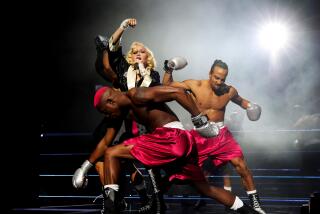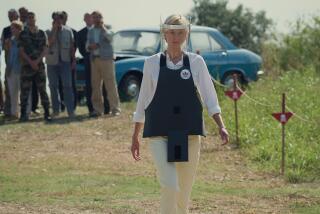Who Are Those Two Singers With Diana Ross?
- Share via
Is Diana Ross interested in revisiting some glory days--or is her newest enterprise just a Supreme insult? The first tickets go on sale this week for the “Return to Love” tour by Ross and the Supremes, but it’s hardly the exciting reunion that had been eagerly awaited by fans. That’s because it doesn’t include Mary Wilson, the only other surviving member of the original Supremes (Florence Ballard died in 1976), or Cindy Birdsong, who performed in the group before Ross went solo in 1970. So who are the Supremes this time around? The other two-thirds are Lynda Laurence and Scherrie Payne--a pair that wore the famous dresses only after Ross’ exodus. A true reunion almost happened: Wilson says she and Birdsong had signed off as recently as last week on a deal that would have put them on stage with Ross, but money and personality issues were the stumbling blocks. Wilson says she had backed down from her original demand of one-third of the profits and agreed to settle for $3 million (compared, she says, to Ross’ potential $20 million take) but that Ross abruptly axed the deal. “I have been waiting for this for years, I’m very disappointed,” says Wilson, who was a Supreme the longest. “I’ve been working for years to keep the Supremes legacy alive and financing it all, the gowns, lawyers, accountants. . . . I never expected this.” At a press conference last week, Ross said the tour is “for the fans” but added, “This was never called a reunion tour; I never considered it a reunion tour.” How will fans react? Internet music sites have been roiling with the topic all week. “I’m sensing a strong groundswell against Ross from both within and without the music industry,” says Pete Howard, editor of ICE, a popular music newsletter. But Gary Bongiovanni of Pollstar, a concert industry trade weekly, says it’s not clear “if the public is knowledgeable enough to recognize that this isn’t the Supremes.” But he also said negative publicity could bruise a tour with a steep ticket price (some seats for $39.50, but an average cost of $125 and a top ticket of $250). “Why [Ross] is choosing to do this now, I don’t personally understand,” Bongiovanni says, adding that as a solo artist she remains a solid draw. Ross and company will also perform on “VH1 Divas 2000: A Tribute to Diana Ross,” taped Sunday in New York and airing Tuesday on VH1.
‘The Decalogue’ Comes to Home Video
“It’s kind of a miracle,” says Milos Stehlik, head of the Chicago-based Facets Multimedia, and devoted film fans eager to see Polish director Krsysztof Kieslowski’s brilliant 10-part gloss on the Ten Commandments, “The Decalogue,” will agree. No more will eager viewers have to be willing to purchase scalped tickets (as happened a few years back at the L.A. County Museum of Art) during one of this film series’ rare public showings. Starting Tuesday, for the first time since Kieslowski made “The Decalogue” more than a decade ago, it will be available for rental and sale (cost: $99.95 per boxed set) on American video for a window lasting at least one year. “It’s a landmark in what’s possible for film. Everyone who sees it is in some way touched, moved or changed by it,” says Stehlik, whose organization handles more than 41,000 titles, “specializing in the art film margins of the video universe, the back alleys of cinema.” He and almost every other video organization has wanted to distribute “The Decalogue” since it was made, but the Canadian company that has owned North American rights had such high hopes for the series (based on its quality, not market realities) that it could never reach an agreement with anyone. “It was,” says Stehlik, “under the blackest of distribution clouds.” Now, with the time when the rights will revert to Polish TV (where the films were originally shown) drawing close, the Canadians were more willing to strike a deal. “We’re really, really excited,” said a spokesperson for Santa Monica’s premier video emporium, Vidiots. “It’s one of those things people ask us for all the time and we’re very happy to tell them its about to become available.”
More Laughs at Dr. Laura’s Expense
Laura Schlessinger seldom has much nice to say about the vulgarity she sees on television, so perhaps it’s no surprise that sitcom writers--especially those spoofing talk radio--would use the nationally syndicated radio personality as fodder for their tomfoolery. Last spring, a “Frasier” episode featured Christine Baranski as Dr. Nora, a ruthless dispenser of on-air advice who clashed with the show’s namesake. This week brings viewers the ABC sitcom “Talk to Me,” whose protagonist--a radio host played by Kyra Sedgwick--feuds with colleague Dr. Debra, a conservative radio psychologist. Premiering Tuesday, “Talk to Me” was created by Suzanne Martin, who previously wrote for “Frasier” but left to develop her show prior to the Dr. Nora episode (conceived by producer Joe Keenan, one of the Paramount employees who have publicly objected to the studio’s affiliation with Schlessinger’s proposed TV show). Martin, meanwhile, said she’s simply fascinated by talk radio, including Dr. Laura. “On the one hand, she drives me crazy,” Martin said. “On the other hand, I listen to her whenever I’m in the car and I have the radio on.” Martin added that she almost regrets using a similar name, since the character changed once Beverly D’Angelo (of the “National Lampoon’s Vacation” films) was cast, capitalizing on the friction created by a sexy woman who regularly preaches abstinence.
--Compiled by Times Staff Writers
More to Read
The biggest entertainment stories
Get our big stories about Hollywood, film, television, music, arts, culture and more right in your inbox as soon as they publish.
You may occasionally receive promotional content from the Los Angeles Times.










